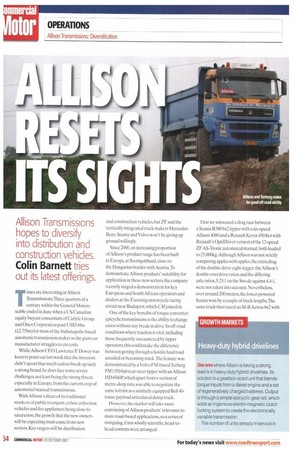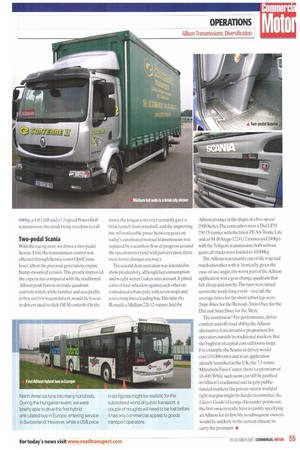I S S S Allison Transmissions
Page 54

Page 55

If you've noticed an error in this article please click here to report it so we can fix it.
hopes to diversify into distribution and construction vehicles.
Colin Barnett tries out its latest offerings.
Times are interesting at Allison Transmissions.Three quarters of a century within the General Motors stable ended in June when a US/Canadian equity buyout consortium of Carlyle Group and Onex Corporation paid US$5.6bn (i2.75bn) for most of the Indianapolis-based automatic transmission maker as the giant car manufacturer struggles to cut costs.
While Allison CEO Lawrence E Dewey was keen to point out last week that the investors didn't spend that much cash to break up such a strong brand, he does face some severe challenges, not least being the strong threat, especially in Europe, from the current crop of automated manual transmissions.
With Allison's share of its traditional markets of public transport. refuse collection vehicles and fire appliances being close to saturation, the growth that the new owners will be expecting must come from new sectors, Key targets will be distribution and construction vehicles, but ZF and the vertically integrated truck makers MercedesBenz, Scania and Volvo won't be giving up ground willingly.
Since 2000, an increasing proportion of Allison's product range has been built in Europe, at Szentgotthard, close to the Hungarian border with Austria.To demonstrate Allison products' suitability for application in these new sectors, the company recently staged a demonstration for key European and South African operators and dealers at the Euroring motorcycle racing circuit near Budapest, which CMjoined in.
One of the key benefits of torque converter/ epicyclic transmissions is the ability to change ratios without any break in drive. In off-road conditions where traction is vital, including those frequently encountered by tipper operators, this could make the difference between getting through a hostile haul road unaided or becoming stuck.The feature was demonstrated by a Volvo FM-based Terberg FM1350 6x6 rear-steer tipper with an Allison HD4560P, which apart from a section of metre-deep ruts, was able to negotiate the same terrain as a similarly equipped Bell 40tonne payload articulated dump truck.
However, the market will take more convincing of Allison products' relevance to more road-based applications, so a series of intriguing, if not wholly scientific, head-tohead contests were arranged. First we witnessed a drag race between a Scania R380 6x2 tipper with a six-speed Allison 4000 and a Renault Kerax 450 8x4 with Renault's OptiDriver version of the 12-speed ZFAS-Tronic automated manual, both loaded to 25,000kg.Although Allison was not strictly comparing apples with apples,the extra drag of the double-drive eight-legger, the Allison's double-overdrive ratios and the differing axle ratios,5.25:1 on the Swede against 44:1, were not taken into account. Nevertheless, over around 200 metres,the lower-powered Scania won by a couple of truck lengths.The same truck then raced an M-B Actros 6x2 with 600hp. a 4.0:1 diff and a 12-speed PowerShift transmission, the result being too close to call.
Two-pedal Scania
With the racing over, we drove a two-pedal Scania.First.the transmission control was effected through Scan ia's own OptiCruise lever, albeit the previous generation, engine hump-mounted version.This greatly improved the experience compared with the traditional Allison push button or crude quadrant controls which,while familiar and acceptable to bus and bin wagon drivers, would be less so to drivers used to slick OEM controls. On the move, the torque converter certainly gave a brisk launch from standstill, and the improving but still noticeable pause between gears on today's automated manual transmissions was replaced by a seamless flow of progress around the speedometer (and with just six ratios, there were fewer changes anyway).
The second demonstration was intended to show productivity, although fuel consumption and weight weren't taken into account. It pitted a trio of four-wheelers against each other on a simulated urban cycle, with seven stops and a reversing into a loading bay.This time the Renault, a Midlum 220 12-tonner,had the Allison product in the shape of a five-speed 2500 Scries.The contenders were a Daf LF55 25015-tonner with the latest ZF AS-Tronic Lite and an M-B Atego 1224(12 tonnes and 240hp) with the Telligent transmission, both with six gears; all trucks were loaded to 10,000kg.
The Allison was smarter out of the trap and much smoother with it. Ironically, given the case-of-use angle, the worst part of the Allison application was a gear change quadrant that felt cheap and notchy.'The runs were timed across the week-long event — overall, the average times for the short urban lap, were 2min 40sec for the Renault. 3min 05sec for the Daf and 3min 26sec for the Mere.
The conclusion? For performance, driver comfort and off-road ability, the Allison alternative is an attractive proposition for operators outside its traditional markets. But the bugbear of capital cost still looms large. For example, the Scania as driven would cost £10000 extra and in an application already launched in the UK, the 7.5-tonne Mitsubishi Fuso Canter, there's a premium of £8.4X). While such sums can still be justified in Allison's traditional and largely publicfunded markets, the private-sector world of tight margins might be harder to convince.As Glass's Guide's George Alexander points out, the first owners really have to justify specifying an Allison for its first life as subsequent owners would be unlikely in the current climate to carry the premium. •


























































































































































































